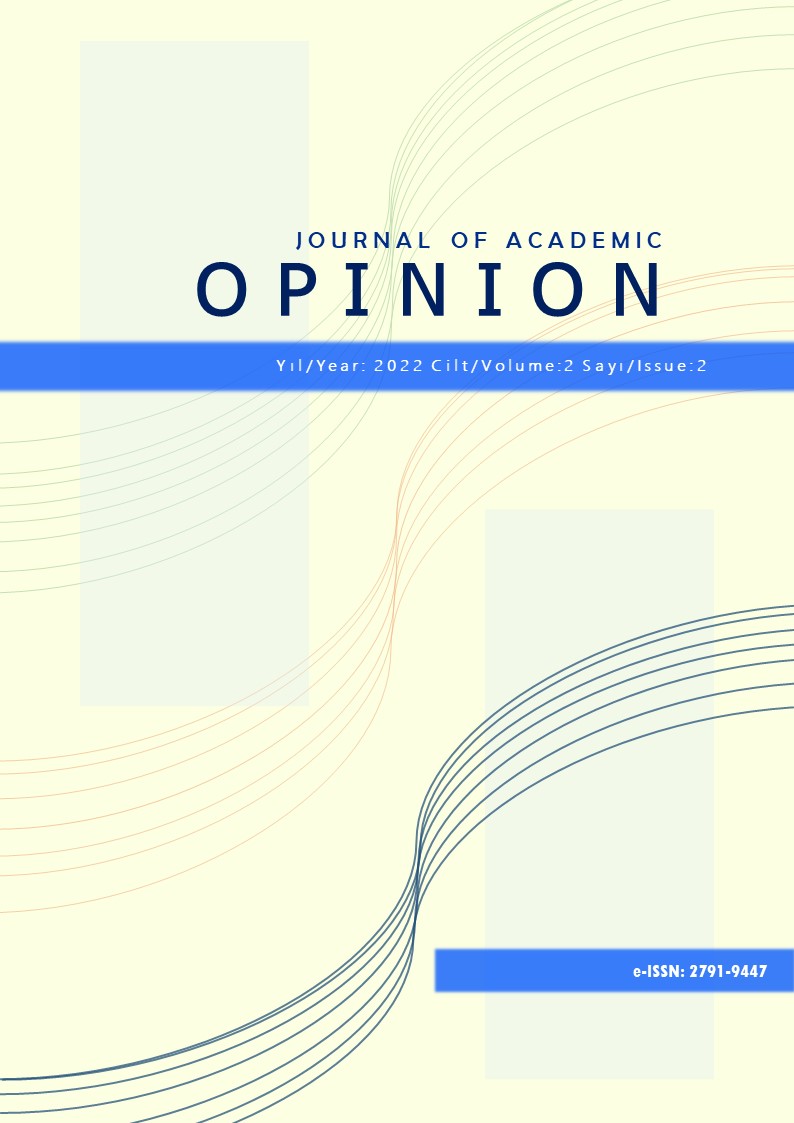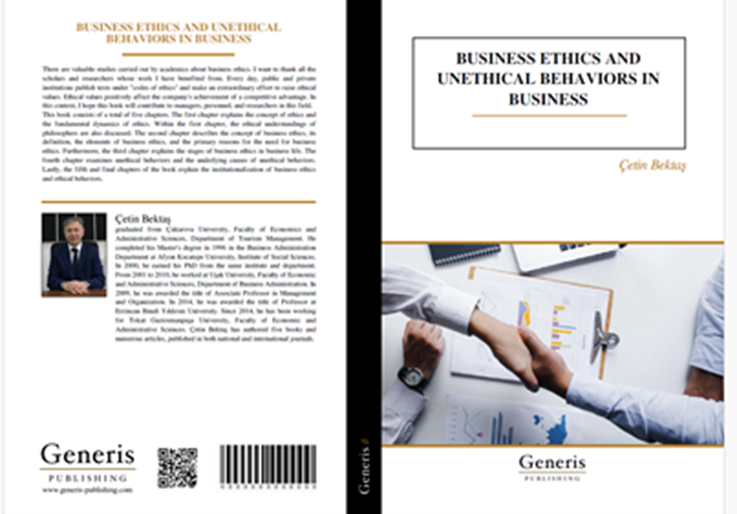Investigation Of Employees' Opinions On Cyberloafing Behavior In Public Institutions
Keywords:
Cyberloafing, Non-Work Activity, Non-Work Internet UseAbstract
In our era, known as the Information Age, the IT and communications infrastructure were spread across vast geographies along with technological advances. Individuals or organizations have seen significant gains in exchanging data and information with each other, especially communications and computing networks. The internet also served an indispensable purpose in public institutions, but facilitated employees to take action in non-work areas. For the personal purposes of staff in the workplace, Internet uses are referred to as virtual slacking. The factors that influence the individual in carrying out this action are becoming more and more important to the institutions. This study is intended to determine whether the thoughts of personnel working in public institutions on virtual shifts vary according to various variables (gender, age, etc.). The research uses a self-knowledge form with the "Virtual Scale of Recovery" developed by researchers during the data collection phase. The study preferred "The Illustrative Method" as a method of research. In Sivas prefecture, 490 people who are employed in public institutions, contracted or employed workers, and are 18 years or older make up the study's universe, and 490 people who are easily identified by face-to-face or online sampling. Analysis of the research data was done by the SPSS 25.0 statistical packet program. As a result of the Kolmogorov-Smirnov Normality Test, where the data distribution is not normal, nonparametric statistical methods (Kruskal Wallis H Test, Mann Whitney U Test, Bonferroni Correction Mann Whitney U Test) were used. The study found that the majority of participants ARTICLE INFOS Article History Received: August 18, 2022 Accepted: September 28, 2022 Article Type Research Article Responsible Author Abdulkerim GÜLER Günel, Y., Güler, A. / Journal of Academic Opinion 2022 2(2) 54-66 55 consider using the internet for individual purposes during business hours; that their ability to use technological tools (computers, smartphones, tablets, etc.) is good; that they use the internet and computer for one or two hours outside of work. In addition, participants' thoughts on virtual shifting are found to be significant differences in gender, marital status, use of the internet for personal purposes, age, educational status, employment status, monthly income, and duration of employment variables in public institutions.
References
Akca, A. (2013). Okul Yöneticilerinin İş Dışı İnternet Kullanım (Siber Aylaklık) Davranışlarının İncelenmesi. Yayınlanmamış Yüksek Lisans Tezi, İstanbul: Yıldız Teknik Üniversitesi Sosyal Bilimler Enstitüsü.
Altunışık, R., Coşkun, R., Bayraktaroğlu, S. ve Yıldırım, E. (2012). Sosyal Bilimlerde Araştırma Yöntemleri, Sakarya: Sakarya Yayıncılık, 7. Baskı.
Anandarajan, M., Simmers, C. ve Igbaria, M. (2000). An Exploratory Investigation of the Antecedents and Impact of Internet Usage: An Individual Perspective. Behaviour and Information Technology, 19(1): 69-85.
Anandarajan, M., Simmers, C. A., ve D'Ovidio, R. (2011). Exploring the underlying structure of personal web usage in the workplace. Cyberpsychology, behavior, and social networking, 14(10): 577-583. doi: 10.1089/cyber.2010.0136.
Arslan, T. E. ve Demir, H. (2016), Sanal Kaytarma: Bir Kamu Kurumunda Hemşireler Üzerinde Ampirik Bir Araştırma. Journal of International Social Research, 9(43): 1626-1626. doi: 10.17719/jisr.20164317733.
Askew, K., Buckner, J., Taing, M., Ilie, A., Bauer, J. ve Coovert, M. (2014). Explaining Cyberloafing: The Role of The Theory of Planned Behavior. Computers in Human Behavior, 36: 510-519.
Avcı, Y. E., Demir, S. ve Üce, Ö. (2022). İdari Personelde Sanal Kaytarma Davranışı İle İş Performansı İlişkisi. Journal of History School, 58: 2087-2103.
Bayer, N. (2021). Hemşirelerde Sanal Kaytarma Davranışının İncelenmesi: Bir Özel Hastane Örneği. Turkish Journal of Science and Health, 2(1): 139-145. https://dergipark.org.tr/en/pub/tfsd/issue/60096/841817.
Blanchard, A.L. ve Henle, C.A. (2008). Correlates of Different Forms of Cyberloafing: The Role of Norms and External Locus of Control. Computers in Human Behavior, 24(3): 1067-1084.
Bock, G. W. ve Ho, S. L. (2009). Non-work related computing (NWRC). Communications of the ACM, 52(4): 124-128. Doi:10.1145/1498765.1498799.
Chak, K. (2003), Shyness and Locus of Control as Predictors of Internet Addiction and Internet Use, A Graduation Project in Partial Fulfillment of the Requirement for the Degree of Master of Science in New Media, The Chinese University of Hong Kong.
Çavuşoğlu, S., Palamutçuoğlu, A. ve Palamutçuoğlu, B.T. (2014). Çalışanların Demografik Özelliklerinin Sanal Kaytarma (Cyberloafing) Üzerindeki Etkisi: Üniversite Çalışanları Üzerinde Ampirik Bir Araştırma. Research Journal of Business and Management, 9(19): 149-168.
Çelik, N. (2014). Job Satisfaction’s Impact On Cyberloafing: An University Example. 10th International Academic Conference, Haziran, Viena.
Demir, İ.P., Ürek, D. ve Uğurluoğlu, Ö. (2017). Sağlık çalışanlarının sanal kaytarma davranışının işte üretkenliklerine etkisi. Online Academic Journal of Information Technology, 8(30): 291-303.
Durmuş, Ş. ve Çelik, A. (2020). Sanal Kaytarma Davranışları ve Zaman Yönetimi Etkileşimi: Karamanoğlu Mehmetbey Üniversitesi Araştırma Görevlileri Örneği. Aksaray Üniversitesi İktisadi ve İdari Bilimler Fakültesi Dergisi, 12(1): 79-86.
Garrett, R. K. ve Danziger, J. N. (2008). Disaffection or Expected Outcomes: Understanding Personal Internet Use During Work. Journal of Computer-Mediated Communication, 13: 937-958.
Güler, A. & Güner, Y. (2022) Kamu Kurumlarında Sanal Kaytarmaya Yönelik Bir Ölçek Geliştirme Çalışması. İşletme Bilimi Dergisi, 10(2), 247-274.
Gültekin, D. ve Ulusoy, H. (2022). Sağlık Çalışanlarında Sanal Kaytarma ve Örgütsel Güven Arasındaki İlişkinin Belirlenmesi. Journal of Healthcare Management and Leadership, (1): 70-97. doi: 10.35345/johmal.1091046.
Hoşgör, H. , Coşkun, F. , Cin, S. ve Ülker Dörttepe, Z. (2021). Hemşirelerin Sanal Kaytarma Davranışlarının, Hizmet Verme Yatkınlıkları Üzerindeki Etkisinin İncelenmesi. Uluslararası Sağlık Yönetimi ve Stratejileri Araştırma Dergisi, 7(2): 366-376. https://dergipark.org.tr/en/pub/usaysad/issue/64697/988581.
Jackson, L. A., Ervin, K. S., Gardner, P. D. ve Schmitt, N. (2001). Gender and the Internet: Women Communicating and Men Searching. Sex Roles, 44: (5/6), 363-379.
Kaplan, M. ve Çetinkaya, A. ġ. (2014). Sanal Kaytarma ve Demografik Özellikler Açısından Farklılıklar: Otel İşletmelerinde Bir Araştırma. Anatolia: Turizm Araştırmaları Dergisi, 25(1): 26-34.
Karaoğlan Yılmaz, F. G., Yılmaz, R., Özturk, H. T, Sezer, B. ve Karademir, T. (2015). Cyberloafing as a Barrier to the Successful Integration of Information and Communication Technologies into Teaching and Learning Environments. Computers in Human Behavior, 45: 290-298.
Koç, K. ve Altuntaş, S. (2021). Sağlık çalışanlarında sanal kaytarma davranışları. Sağlık ve Hemşirelik Yönetimi Dergisi, 8(2): 284-292.
Küçük, F. ve Nur, E. (2019). Sanal Kaytarma Davranışları İle İş Verimliliği Arasındaki İlişki: Harran Üniversitesinde Çalışan Akademik ve İdari Personel Üzerine Bir Araştırma. International Social Science Journal, 12(66): 1102-1116. doi: 10.17719/jisr.2019.3656.
Lee, Z., Lee, Y. ve Kim, Y. (2004). Personal Web Usage in Organizations. Personal Web Usage in the Workplace: A Guide to Effective Human Resources Management (editörler: M. Anandarajan ve C. Simmers), Information Science Publishing.
Lim, V. K. (2002). The IT way of loafing on the job: cyberloafing, neutralizing and organizational justice. Journal of Organizational Behavior, 23(5): 675-694.
Lim, V. K. ve Chen, D. J. (2012). Cyberloafing at the Workplace: Gain or Drain on Work?. Behaviour & Information Technology, 31(4): 343-353, doi:10.1080/01449290903353054.
Lim, V. K. ve Teo, T. S. (2005). Prevalence, perceived seriousness, justification and regulation of cyberloafing in Singapore: An exploratory study. Information & Management, 42(8): 1081-1093. https://doi.org/10.1016/j.im.2004.12.002.
Morahan-Martin, J. (2001). Caught in the Web: Research and Criticism of Internet Abuse with Application to College Students, Learning and teaching on the World Wide Web, (editör: C. R. Wolfe), 191-219, Academic Pres, San Diego, CA, aktaran: Liberman, B. Seidman, McKenna, G. K. ve Buffardi, L. E. (2011) Employee Job Attitudes and Organizational Characteristics as Predictors of Cyberloafing. Computers in Human Behavior, 27: 2192-2199.
Örücü, E. ve Yıldız, H. (2014). İşyerinde kişisel internet ve teknoloji kullanımı: Sanal kaytarma. Ege Akademik Bakış, 14(1): 99-114. https://dergipark.org.tr/en/download/article-file/560040.
Özdem, G. ve Demir, A. (2015). Okul Yöneticilerinde Sanal Kaytarma Davranışı . Mersin Üniversitesi Eğitim Fakültesi Dergisi, 11(3): 1030-1042. https://dergipark.org.tr/en/pub/mersinefd/issue/17398/182040.
Özkalp, E., Aydın, U. ve Tekeli, S. (2012). Sapkın Örgütsel Davranışlar ve Çalışma Yaşamında Yeni Bir Olgu: Sanal Kaytarma (Cyberloafing) ve İş İlişkilerine Etkileri. Çimento İşveren Dergisi, 26(2): 18-33.
Ramayah, T. (2010). Personal Web Usage and Work Inefficiency. Business Strategy Series, 11(5): 295-301.
Sadıç, E. , Eğilmez, Ö. ve Haşit, G. (2020). Üniversite Çalışanları Bağlamında Sanal Kaytarma ve Örgütsel Vatandaşlık Davranışı Üzerine Bir İnceleme. Bilecik Şeyh Edebali Üniversitesi Sosyal Bilimler Dergisi, 5(2): 234-256. doi: 10,33905/bseusbed.777522.
Tabachnick, B. G. ve Fidell, L. S. (2007). Using Multivariate Statistics, Boston MA: Allyn & Bacon, (Hale, I. (2015). Ergenler İçin Oyun Bağımlılığı Ölçeğinin Türkçe’ye Uyarlama Çalışması, Elementary Education Online, 14(2): 874-884.
Tavşancıl, E. (2010). Tutulumların Ölçülmesi ve SPSS ile Veri Analizi, Ankara: Nobel Basım Yayın, 4. Baskı.
Ugrın, J. C., Pearson, J. M. ve Odom, M. D. (2008). Profiling Cyber-Slackers in the Workplace: Demographic, Cultural, and Workplace Factors. Journal of Internet Commerce, 6(3): 75-89.
Ünal, F. ve Tekdemir, S. (2015). Sanal kaytarma: Bir kamu kurumunda ampirik bir araştırma. Süleyman Demirel Üniversitesi İktisadi ve İdari Bilimler Fakültesi Dergisi, 20(2): 97-99. https://dergipark.org.tr/tr/download/article-file/194136.
Ürek, D. , Bilgin Demir, İ. ve Uğurluoğlu, Ö. (2018). Sağlık Çalışanlarının Sanal Kaytarma Davranışlarının İncelenmesi: Bir Üniversite Hastanesi Örneği. Anadolu Üniversitesi Sosyal Bilimler Dergisi, 18(2): 135-148. doi: 10.18037/ausbd.552423.
Vıtak, J., Crouse, J. ve La Rose, R. (2011). Personal Internet Use at Work: Understanding Cyberslacking. Computers in Human Behavior, 27: 1751-1759.
Wallace, P. (2004). The Internet in the Workplace: How New Technology is Transforming Work (1st Edition). Cambridge University Press.
Weissenfeld, K., Abramova, O. ve Krasnova, H. (2019). Antecedents for cyberloafing- A literatüre review. International Conference on Wirthschaftsinformatiki, 1687-1701.
Yıldırım, E. ve Öztürk, U. (2022). Örgütsel Davranışlarda Ölçek Araştırmaları: Sanal Kaytarma. Eğitim Yayınevi. E-book.
Downloads
Published
How to Cite
Issue
Section
License
Copyright (c) 2022 Journal of Academic Opinion

This work is licensed under a Creative Commons Attribution 4.0 International License.





